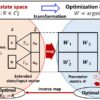Researchers at the Karlsruhe Institute of Technology (KIT) have developed a prototype for fully scalable all-perovskite tandem solar modules. These modules have an efficiency of up to 19.1% with an aperture area of 12.25 square centimeters. This result, the first of its kind reported worldwide, was made possible by improving efficiency with optimized light paths, high-throughput laser scribing, and the use of established industrial coating methods. The researchers present their results in the journal Nature Energy.
As a readily available and versatile energy source, sunlight plays a key role in the transition from fossil fuels to renewable sources and in an independent energy supply. Solar cells convert sunlight into electricity. In recent years, solar cells made of perovskite semiconductors have shown great promise thanks to their high efficiency and low production costs. But the efficiency of an individual perovskite cell is still limited in spite of enormous progress. This limitation can be overcome by stacking two solar cells with different band gaps. The band gap is a material characteristic that determines the part of the incident spectrum that a solar cell absorbs to generate electricity.
Efficiency boost from stacking
Tandem solar cells use a broader range of the spectrum and generate more electricity, making them more efficient. Perovskite solar cells with a tunable band gap are ideal tandem partners not only for solar cells made of other materials but also for all-perovskite tandem solar cells. They feature low-cost production, solution-based processing methods, mechanical flexibility, and the freedom to combine cells with different perovskite band gaps. Researchers expect all-perovskite tandem solar cells to gain a high market share in the future if they can satisfy requirements for stability and scalability. Scalability means that new designs can be applied at larger scales and in mass production.
The department headed by Tenure-Track Professor Ulrich W. Paetzold from the Institute of Microstructure Technology (IMT) and the Light Technology Institute (LTI) at KIT has succeeded in developing a scalable prototype for high-efficiency all-perovskite tandem solar modules. The researchers were able to scale up individual perovskite cells with an efficiency of up to 23.5% at an aperture area of 0.1 square centimeters to all-perovskite tandem solar modules with an efficiency of 19.1% at an aperture area of 12.25 square centimeters. The aperture area is the usable part of the surface that is not covered by electrodes, frames or fasteners. At approximately 5%, the loss of efficiency when upscaling is relatively low. “This is the first report of an all-perovskite tandem solar module worldwide,” says Dr. Bahram Abdollahi Nejand, lead author of the publication and team leader for all-perovskite tandem solar modules.
Upscaling enabled by three innovations
This remarkable result is based on three key innovations. The KIT researchers increased the efficiency by optimizing the light path and reducing reflections in the solar cell architecture. They implemented an efficient layout for tandem solar modules using high-throughput laser scribing that enables the production of functional tandem solar mini-modules with two-terminal interconnected cell strips. Lastly, they used coating processes (blade coating and vacuum deposition) that are already established industrial practice.
“Achieving this outstanding research result was only possible with the combined expertise at KIT. This will provide motivation for further work in academia and industry to make the sustainable and pioneering technology of all-perovskite tandem solar modules commercially viable through upscaling and improvements in stability,” says Paetzold.
More information:
Bahram Abdollahi Nejand et al, Scalable two-terminal all-perovskite tandem solar modules with a 19.1% efficiency, Nature Energy (2022). DOI: 10.1038/s41560-022-01059-w
Provided by
Karlsruhe Institute of Technology
Citation:
Fully scalable all-perovskite tandem solar modules (2022, July 14)


